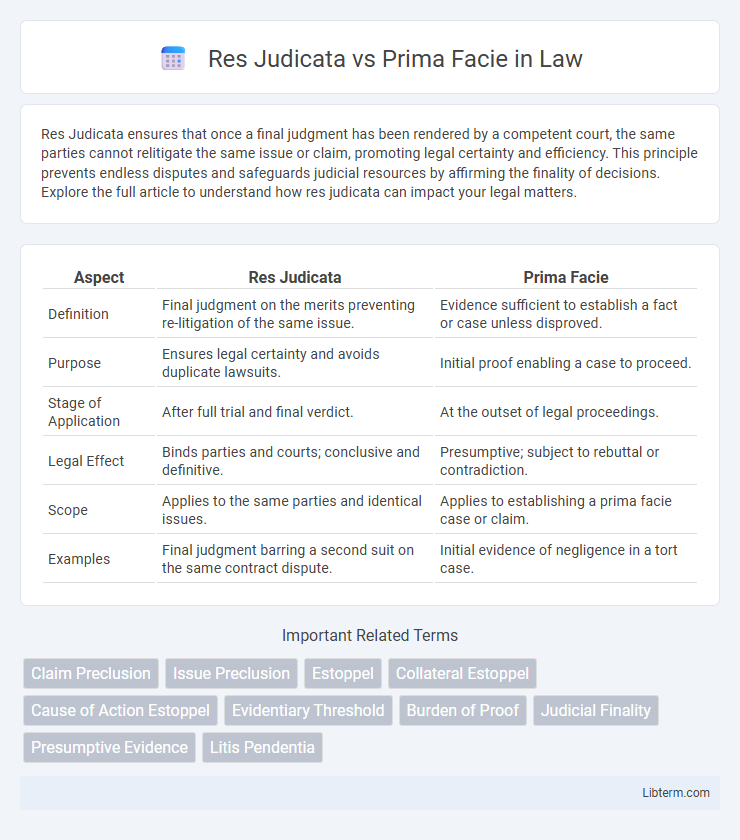Res Judicata ensures that once a final judgment has been rendered by a competent court, the same parties cannot relitigate the same issue or claim, promoting legal certainty and efficiency. This principle prevents endless disputes and safeguards judicial resources by affirming the finality of decisions. Explore the full article to understand how res judicata can impact your legal matters.
Table of Comparison
| Aspect | Res Judicata | Prima Facie |
|---|---|---|
| Definition | Final judgment on the merits preventing re-litigation of the same issue. | Evidence sufficient to establish a fact or case unless disproved. |
| Purpose | Ensures legal certainty and avoids duplicate lawsuits. | Initial proof enabling a case to proceed. |
| Stage of Application | After full trial and final verdict. | At the outset of legal proceedings. |
| Legal Effect | Binds parties and courts; conclusive and definitive. | Presumptive; subject to rebuttal or contradiction. |
| Scope | Applies to the same parties and identical issues. | Applies to establishing a prima facie case or claim. |
| Examples | Final judgment barring a second suit on the same contract dispute. | Initial evidence of negligence in a tort case. |
Introduction to Res Judicata and Prima Facie
Res Judicata refers to the legal principle that a final judgment by a competent court is conclusive and prevents the same parties from relitigating the same issue. Prima Facie denotes the initial evidence presented in a case sufficient to establish a fact unless contradicted by rebuttal evidence. Both concepts play essential roles in the judicial process, with Res Judicata ensuring finality and Prima Facie establishing a baseline for legal claims.
Legal Definition of Res Judicata
Res Judicata is a legal doctrine preventing the same parties from litigating a claim that has already been conclusively settled by a competent court. It ensures finality and judicial efficiency by barring re-examination of issues that were or could have been raised in the initial lawsuit. Prima Facie refers to evidence sufficient to establish a fact or raise a presumption unless disproved, but unlike Res Judicata, it does not constitute a conclusive judgment.
Legal Definition of Prima Facie
Prima facie, in legal terms, refers to evidence that is sufficient to establish a fact or raise a presumption unless disproved, serving as the initial threshold for a party's claim or defense. Res judicata, conversely, prevents relitigation of a claim or issue that has already been conclusively settled by a competent court. The key distinction lies in prima facie being the preliminary assessment of evidence, while res judicata is a final judgment bar on repetitive lawsuits.
Historical Evolution of Both Doctrines
The doctrine of Res Judicata has its roots in Roman law, evolving through centuries as a principle to prevent legal disputes from being relitigated once a final judgment is rendered, ensuring legal certainty and finality. Prima Facie originates from Latin, meaning "at first sight," and developed mainly within common law systems as a rule to assess whether evidence presented is sufficient to establish a fact or case unless disproven. Both doctrines have evolved through historical legal precedents to serve distinct functions: Res Judicata ensures conclusiveness of judgments, while Prima Facie focuses on preliminary evidential sufficiency in litigation.
Core Differences Between Res Judicata and Prima Facie
Res Judicata is a legal doctrine preventing the same dispute from being litigated once a court has issued a final judgment, ensuring finality and judicial efficiency. Prima Facie refers to the establishment of sufficient evidence on the face of a claim that, unless rebutted, is adequate to prove a case at trial. The core difference lies in Res Judicata addressing the conclusiveness of a final judgment, whereas Prima Facie concerns the initial threshold of evidence required to proceed with a legal claim.
Importance in Civil Litigation
Res judicata prevents re-litigation of cases by ensuring finality in civil litigation, conserving judicial resources and promoting legal certainty. Prima facie establishes initial evidence sufficiency, guiding courts in deciding whether a case should proceed to trial. Both doctrines are critical: res judicata upholds the integrity of verdicts, while prima facie safeguards plaintiffs' right to a fair hearing.
Real-World Applications: Case Law Comparisons
Res judicata prevents re-litigation of a final judgment between the same parties, as seen in *Plell v. Mitchell* (1993), ensuring judicial efficiency and consistency. Prima facie refers to evidence sufficient to establish a fact unless disproved, exemplified in *Anderson v. Liberty Lobby, Inc.* (1986), where the court assessed whether the evidence could support a verdict. These doctrines guide courts in case law by balancing conclusive judgments with initial evidentiary thresholds in diverse legal contexts like civil disputes and criminal prosecutions.
Limitations and Exceptions to Each Principle
Res Judicata limits re-litigation by barring claims that have been finally adjudicated, but exceptions include cases of fraud, lack of jurisdiction, or newly discovered evidence. Prima Facie establishes an initial burden of proof requiring sufficient evidence to proceed, yet exceptions arise when evidence is rebutted or procedural flaws exist. Both principles ensure judicial efficiency but are constrained by fairness and due process considerations.
Practical Implications for Legal Professionals
Res Judicata prevents re-litigation of cases by ensuring decisions are final and binding, reducing court backlog and providing legal certainty for practitioners. Prima Facie establishes a preliminary burden of proof, guiding lawyers in assessing case viability and strategizing early legal arguments. Understanding these doctrines enhances efficient case management and informed decision-making in litigation practice.
Conclusion: Choosing the Right Doctrine in Legal Strategy
Res Judicata ensures finality by preventing re-litigation of cases already judged, securing legal certainty and efficient judicial resource use. Prima Facie serves as an initial assessment to determine whether sufficient evidence exists to proceed, facilitating early case filtering and judicial economy. Selecting the appropriate doctrine hinges on case specifics, where Res Judicata suits concluded disputes and Prima Facie supports preliminary evaluation in legal strategy.
Res Judicata Infographic

 libterm.com
libterm.com